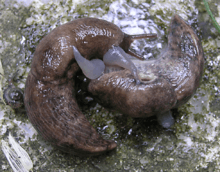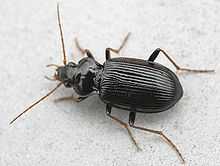Deroceras reticulatum
| Deroceras reticulatum | |
|---|---|
 | |
| Adult Grey Garden Slug [1] | |
| Conservation status | |
| NE[2] | |
| Scientific classification | |
| Kingdom: | Animalia |
| Phylum: | Mollusca |
| Class: | Gastropoda |
| (unranked): | clade Heterobranchia clade Euthyneura clade Panpulmonata clade Eupulmonata clade Stylommatophora informal group Sigmurethra clade limacoid clade |
| Superfamily: | Limacoidea |
| Family: | Agriolimacidae |
| Genus: | Deroceras |
| Species: | D. reticulatum |
| Binomial name | |
| Deroceras reticulatum (O. F. Müller, 1774)[3] | |
| Synonyms[4] | |
|
Limax reticulatus Müller, 1774 | |
Deroceras reticulatum, common names the "grey field slug" and "grey garden slug", is a species of small air-breathing land slug, a terrestrial pulmonate gastropod mollusk in the family Agriolimacidae. This species is an important agricultural pest.
Distribution
Native distribution of this slug species is Europe, North Africa and the Atlantic Islands. It occurs widely in Europe, but is more rare and restricted to cultivated fields in the southeast, particularly in the Balkans, and is probably absent from Greece and the Bulgarian mountains.[4] In the north and central European lowlands, Great Britain, and Ireland, it is probably the most widely occurring slug.[4] In northern Scandinavia it is scarce, and is mainly found as a synanthrope.[4]
This species occurs in countries and islands including:
- Great Britain
- Ireland
- Austria
- Bulgaria
- Czech Republic[5] - least concern (LC)[6]
- Netherlands[7]
- Poland
- Slovakia[5]
- Sweden
- Latvia
- Ukraine[8]
The species has been widely introduced as a synanthrope to many regions:
- North America,[4] in parts of Northern Michigan and Southern Michigan[citation needed]
- Colombia[9]
- Peru[4]
- Argentina - major slug pest in Buenos Aires province[10]
- Tasmania[4]
- New Zealand[4]
- central Asia[4]
Description

a - atrium
p - penis
s - stimulator
mr - musculus retractor penis
gp - glandula penis
bc - bursa copulatrix
ov - oviductus.

As all other Deroceras it has a short keel at the back of the body. Deroceras reticulatum is very variable in colour, creamy or light coffee cream, rarely blackish spotted (slugs with spots may appear blackish).[4] Behind the mantle there is the dark spots form a reticulate pattern.[4] The skin is thick.[4] Mucus is colourless, on irritation milky white.[4] The slug cannot be distinguished from many other Deroceras species based only on its external appearance.[4]
This slug can be up to 40–60 mm long (preserved 25–30 mm).[4] The size varies according to the habitat.[4]
Reproductive system: Penis is fleshy and with a silky sheen, in the shape of an irregular sac, in fully mature specimens divided into 2 parts by a deep lateral constriction.[4] Penial gland has very variable shape, usually a few branches or a single long branch.[4] Stimulator is large, conical and narrow.[4] Retractor of the penis is inserted laterally.[4] Vas deferens opens into penis wall facing the external body side.[4] Rectal caecum is large.[4]
This slug can travel up to 40 feet (12.2 m) in one night.[11]
Ecology
Habitat
Deroceras reticulatum is almost exclusively restricted to cultivated areas, usually in open habitats, in meadows, near roadsides, in ruins, gardens and parks, not inside forests.[4] It shelters under stones and ground litter (It does not burrow into the soil).[4] It is active at night.[4]
Feeding habits
This species is omnivorous, feeding mainly on fresh leaves and fruits or seedings.[4] Deroceras reticulatum is a serious pest of agricultural crops, garden cultivations[4] and horticulture.[11] After several years with continuous moist weather conditions abundance can seriously increase.[4]
Life cycle

Life cycle covers a few months, usually two generations.[4] The main reproductive phase is in summer and autumn.[4] It lays hundreds of eggs which hatch during early summer.[11]
Maximum age is about a year.[4] Slugs die at the first frosts.[4] Usually only eggs hibernate, sometimes also juveniles.[4]

Predators
Various carabid beetles are predators of Deroceras reticlatum, including:
- the European garden beetle Carabus nemoralis, is a beneficial predator (from the human perspective) because it eats the young of this species and also their eggs.[11]
- Pterostichus melanarius[12]
- Pterostichus madidus[10]
- Nebria brevicollis[10]
- Scarites anthracinus eats eggs and slugs in Argentina.[10]
- Poecilus cupreus[12]
Parasites
The bacterium Moraxella osloensis is a mutualistic symbiont of the slug-parasitic nematode Phasmarhabditis hermaphrodita.[13] In nature, Phasmarhabditis hermaphrodita vectors Moraxella osloensis into the shell cavity of the slug host Deroceras reticulatum in which the bacteria multiply and kill the slug.[13]
Deroceras reticulatum can transfer Escherichia coli on its body surface.[14]
Parasites of Deroceras reticulatum include:
References
This article incorporates CC-BY-2.0 text from the reference [13] and public domain text from the reference.[4]
- ↑ Cirrus Digital: Gray Garden Slug Deroceras reticulatum
- ↑ 2006 IUCN Red List of Threatened Species. <www.iucnredlist.org>. Cited 10 May 2007.
- ↑ Müller O. F. (1774). Vermivm terrestrium et fluviatilium, seu animalium infusoriorum, helminthicorum, et testaceorum, non marinorum, succincta historia. Volumen alterum. pp. I-XXXVI [= 1-36], 1-214, [1-10]. Havniae & Lipsiae. (Heineck & Faber).
- ↑ 4.0 4.1 4.2 4.3 4.4 4.5 4.6 4.7 4.8 4.9 4.10 4.11 4.12 4.13 4.14 4.15 4.16 4.17 4.18 4.19 4.20 4.21 4.22 4.23 4.24 4.25 4.26 4.27 4.28 4.29 4.30 4.31 4.32 4.33 "Species summary for Deroceras reticulatum". AnimalBase, last modified 29 August 2010, accessed 10 December 2010.
- ↑ 5.0 5.1 (Czech) Horsák M., Juřičková L., Beran L., Čejka T. & Dvořák L. (2010). "Komentovaný seznam měkkýšů zjištěných ve volné přírodě České a Slovenské republiky. [Annotated list of mollusc species recorded outdoors in the Czech and Slovak Republics]". Malacologica Bohemoslovaca, Suppl. 1: 1-37. PDF.
- ↑ Juřičková, L.; Horsák, M.; Beran, L. (2001). "Check-list of the molluscs (Mollusca) of the Czech Republic". Acta Soc. Zool. Bohem 65: 25–40.
- ↑ http://www.anemoon.org/anm/voorlopige-kaarten/landmollusken/wetenschappelijk/deroceras-reticulatum
- ↑ Balashov I. & Gural-Sverlova N. 2012. An annotated checklist of the terrestrial molluscs of Ukraine. Journal of Conchology. 41 (1): 91-109.
- ↑ Hausdorf B. (May 2002). "Introduced Land Snails and Slugs in Colombia". Journal of Molluscan Studies 68 (2): 127–131. doi:10.1093/mollus/68.2.127. PMID 12011238.
- ↑ 10.0 10.1 10.2 10.3 Tulli M. C., Carmona D. M., López A. N., Manetti P. L., Vincini A. M. & Cendoya G. (2009). "Predation on the slug Deroceras reticulatum (Pulmonata: Stylommatophora) by Scarites anthracinus (Coleoptera: Carabidae)". Ecología Austral. 19: 55-61. PDF.
- ↑ 11.0 11.1 11.2 11.3 "PACIFIC NORTHWEST NURSERY IPM. Snails/Slugs". Oregon State University, last modified 29 July 2005.
- ↑ 12.0 12.1 Oberholzer F. & Frank T. (2003). "Predation by the carabid Beetles Pterostichus melanarius and Poecilus cupreus on Slugs and Slug Eggs". Biocontrol Science and Technology 13(1): 99-110. doi:10.1080/0958315021000054421.
- ↑ 13.0 13.1 13.2 An R., SreevatsanS. & Grewal P. S. (2008). "Moraxella osloensis Gene Expression in the Slug Host Deroceras reticulatum". BMC Microbiology 8: 19. doi:10.1186/1471-2180-8-19.
- ↑ Sproston, E. L.; MacRae, M.; Ogden, I. D.; Wilson, M. J.; Strachan, N. J. C. (2006). "Slugs: Potential Novel Vectors of Escherichia coli O157". Applied and Environmental Microbiology 72 (1): 144–149. doi:10.1128/AEM.72.1.144-149.2006. PMC 1352200. PMID 16391036.
- ↑ Michigan Department of Natural Resources and Environment. "Brainworm". accessed 14 December 2010.
External links
| Wikimedia Commons has media related to Deroceras reticulatum. |
- Deroceras reticulatum at National Center for Biotechnology Information (NCBI)
- Deroceras reticulatum on the UF / IFAS Featured Creatures Web site